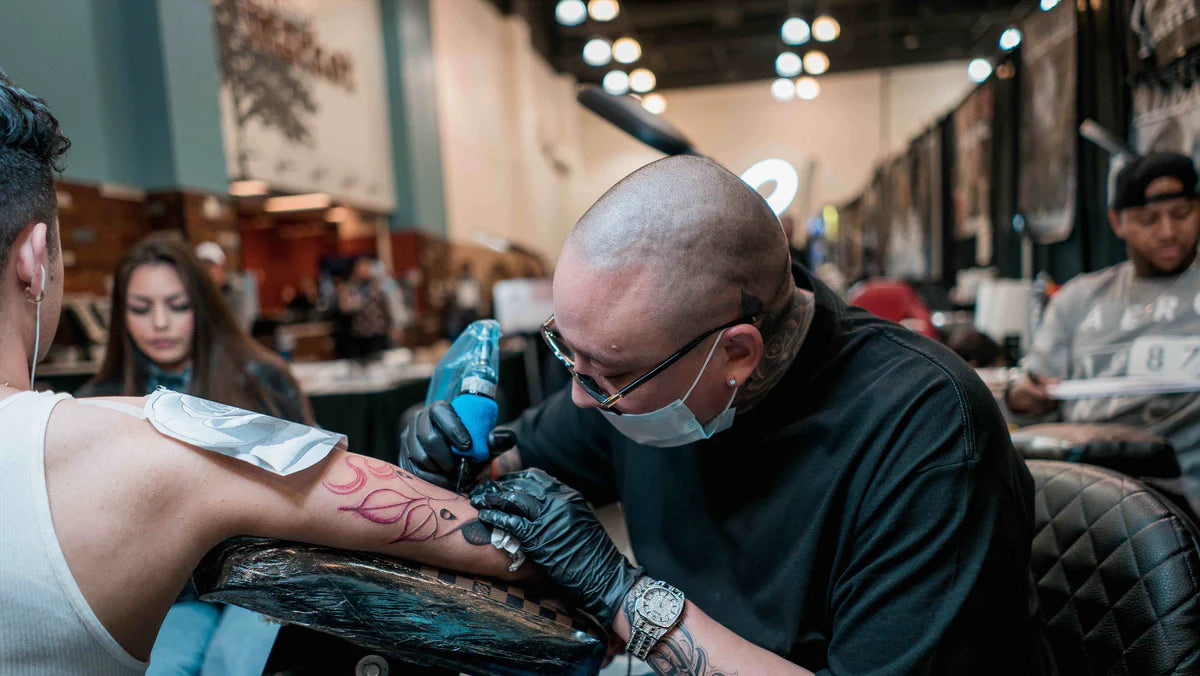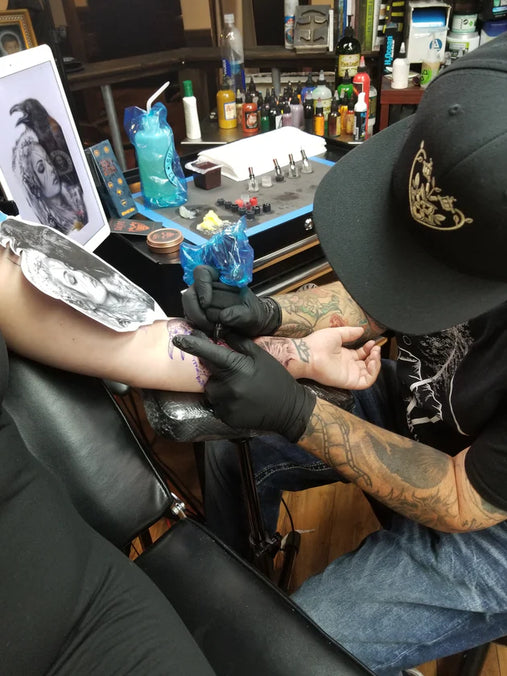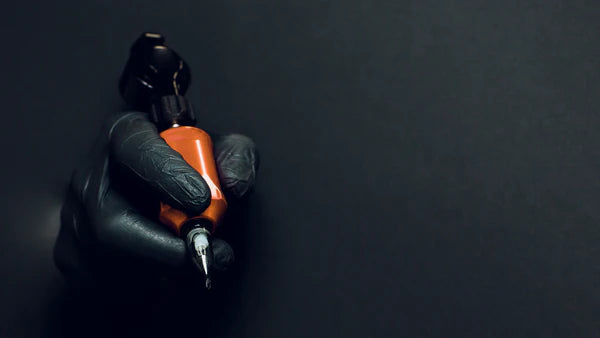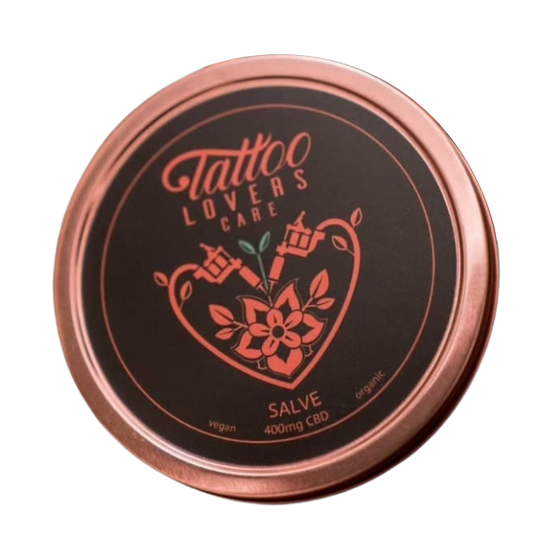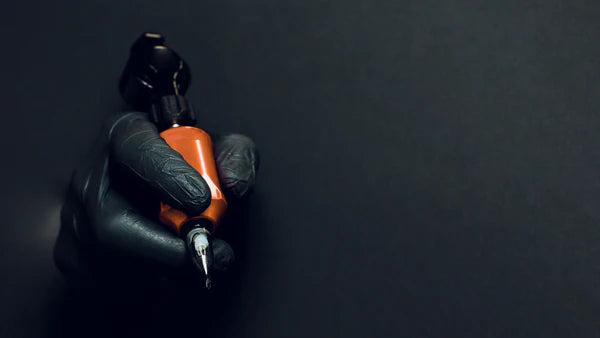
Best Tattoo Aftercare: A Step-By-Step Guide For New Tattoos
In this guide, I'll take you step-by-step through the process of healing your new tattoo. By following these instructions, healing your tattoo will be easy, free of pain, and with minimal chances of infection.
To begin, we'll learn how to care for your tattoo during the first 48 hours. Then we'll guide you week-by-week, ensuring you get the best tattoo aftercare.
Let's dive in.
Tattoo Care For The First 48 Hours
The first 48 hours are critical. If not correctly cared for, your tattoo can suffer permanent damage. During this time, tattoos are especially vulnerable to infection and ink loss.
What To Do Before You Leave The Tattoo Shop
Before we get going, I want to stress the importance of listening to the tattoo aftercare instructions your tattoo artist has given you.
Your artist knows what they are talking about and if you ever run into trouble or don't know what to do, reach out to them. If they can't help you, this guide will be able to tell you what to do.
To begin, these four rules are the core of all tattoo aftercare.
- Keep it clean
- Keep it hydrated
- Don't pick or scratch your tattoo
- Keep it out of the sun
Remembering these rules, you should have a safe and easy healing process.
Hours 1-12: Keep It Clean
You'll hear this a lot throughout the guide, but the key to a bright and crisp tattoo is keeping it clean as it heals.
When your tattoo is complete, and your artist has given you aftercare instructions, you'll more than likely leave the shop with your tattoo wrapped in plastic film—the same stuff you use to wrap up leftovers before throwing them in the fridge.
How long this plastic wrap stays over your tattoo depends on your tattoo artist's instructions—we suggest you leave it on overnight.
Your tattoo needs to do a lot of funky stuff in this first 12-hour period. It will bleed, ooze, swell, and hurt. Do not be alarmed by what's happening; you've technically undergone a medical procedure, and your skin has sustained a lot of trauma.
Leaving the wrap on gives your body the time it needs to begin the healing process.
What's happening at this time is your body is responding to the wound on your skin. Your body will send plasma and white blood cells to the wound to create a scab.
A scab is your body's natural defense against infection. The plasma will be clear and might have a tinge of blood to it.
Do not be alarmed. This is normal, and a part of the process, and the plasma will subside in a few days.
Once you take the wrap off (as directed by your tattoo artist), you'll need to wash your tattoo and the area around it immediately.
Do not touch your tattoo with dirty hands.

Your skin will feel tight and dry when you take the wrap off. This is normal. You won't be able to see it because of the ink, but your tattoo is all raw skin and needs to be treated as an open wound.
Wash your hands first, then wash your tattoo with unscented and fragrance-free antibacterial soap.
Dial Gold soap is often suggested for tattoos, but I've found that Dial dries out your skin badly. Dry skin can be brutal when you have a new tattoo.
When washing your tattoo, use gentle circular motions with a very light touch. You aren't scrubbing dirt and grim off your hands after yard work; this is delicate work—use caution.
Be selective when choosing a soap. We already covered buying fragrance-free antibacterial soap, but I prefer a brand that turns the soap to foam when dispensed from the container.
You can take it a step further and buy foam soap specially formulated for tattoos, like TLC's Tattoo Foam Soap.

Foam soap is an excellent option because of how gentle and effective the foam can be.
When we shower or wash our hands, we scrub until the soap lathers to a thick foam and use the bubbles to clean. But with foam soap, you don't need all the friction required to achieve these cleansing suds.
TLC's foam soap contains essential oils to combat the bacteria while at the same time soothing the skin.
After you have washed your tattoo, and patted it dry with a paper towel, you'll want to use a hydrating balm/salve on your tattoo. There are a lot of opinions on the best type of salve, but there's one thing to remember above everything else.
Do not use petroleum-based balms and salves on your tattoo.
These petroleum-based products smother your tattoo and do not allow it to breathe.
Tattoos need oxygen to heal, and these balms trap moisture and bacteria inside, making it much more likely that you'll get an infection which could lead to scarring and ink loss.
Balms and salves are essentially the same, but balms have a thicker, denser consistency which is why we suggest a salve. It’s gentler on your new tattoo.
Use a salve that is made with natural oils and butters. These natural forms of hydration sink deep into your skin to help with the healing process and help ease pain.
We recommend using TLC's Tattoo Salve.

TLC salves are designed explicitly for healing tattoos, alleviating pain, and nourishing skin. It targets all the issues that arise from healing tattoos, especially in the first 48 hours.
The salve is made from Jojoba oil, Arnica, and Shea butter. Each has anti-inflammatory properties that work together to alleviate pain, reduce swelling, prevent itchiness, and promote healing from within.
To apply, first, wash your hands and then your tattoo. Gently pat your tattoo dry with a paper towel. Then, rub TLC's Tattoo Salve onto your fingers and apply it directly to your tattoo in a thin layer.
Repeat this step whenever your tattoo feels dry or when it's time to clean your tattoo again during the healing process.
We suggest you wash your tattoo with foam soap and apply your salve 2-3 times a day for the next 1-2 weeks, depending on how your tattoo is healing.
It needs to be said right now that you don't EVER want to take a bath or submerge your tattoo in water as it's healing.
It is an easy way to get infected and is terrible for your tattoo, especially once scabs have formed.
Take showers, and don't take too long of a shower. We'll go into more details below.
Hours 12-24: Keep Your Tattoo Hydrated
You made it through the first night. Sleep might have been a little bit difficult, but each night should be a little bit easier.
If you woke up and found that your tattoo leaked while you slept, that's not a bad thing, and there's no need to be alarmed.
In fact, I would suggest putting on a pair of old bed sheets for the first week because tattoo ink stains forever, and it will randomly leak ink every now and then, but after about two days, you should be fine.
If you slept with your wrap on, the likelihood of your tattoo leaking goes up because the moisture and plasma of your skin collect under the plastic and drains out wherever it finds an escape.
Here's the thing about the second day of a healing tattoo—it's exactly like the first.
The goal is to keep your tattoo clean and hydrated.
Use foam soap, salve, and drink lots of water.
That's it.

Get a routine going to execute these two goals. If you work in the morning, do it before work, on your lunch, when you get home, and then one more time before you go to bed.
This might feel excessive to some people, but it's imperative to help your tattoo heal.
Following this routine will ensure that you stay infection free, your tattoo will heal as quickly as possible, and there will be minimal ink loss.
How your tattoo heals can have a dramatic impact on the long-term looks of your tattoo.
Hours 24-36: Continue Your Tattoo Aftercare Routine
It's not a complicated process, but don't begin to think that your tattoo is ready to go out on the town.
By this time, you might be thinking of going to the beach, a pool party, a hike, or anything that involves putting your tattoo in a new environment.
Unless you have to, don't do it.
New tattoos (also tattoos in general) and the sun do not get along. The sun fades ink quickly, and if your tattoo is brand new, it hurts incredibly bad to get direct sunlight on it. You'll see.
What this means is you need to continue your new tattoo aftercare routine. It's tempting to show off your new ink, but for the sake of healing and longevity, keep it clean, hydrated, and out of the sun.
It's not sexy or fun, but you must repeat this process until your tattoo is fully healed.
Hours 36-48: Resist The Urge To Touch Your Tattoo
At this point, you have your tattoo aftercare routine in place. You're a master of gently washing your tattoo and applying salve to keep it hydrated.
What is left to do?
Resist the urge to touch your tattoo.
Depending on how quickly your body heals, you might see dry skin showing up around the edges or finer lines of your tattoo.
Do not, under any circumstances, pick at your tattoo.
It's human nature to pick at things on our bodies. If you have a zit, you'll pop it. If you have a sore tooth, you'll poke it with your tongue, and when you have dry skin, we want to pick at it.
DO NOT PICK AT YOUR TATTOO.
At the end of day two, there won't be a lot of dry skin (if any), but you need to reach down deep and summon all your discipline to not touch your tattoo unless you are cleaning it or putting on salve.
If your clothes irritate your skin, try wearing loose-fitting clothing. If you have a tattoo on your leg and you wear skinny jeans, you might have a problem.
Embrace comfortable baggy clothing until your tattoo is healed enough to struggle back into your tight pants without damaging your ink.
Best Tattoo Aftercare For The Next 4 Weeks
You've made it through the first 48 hours, but what will the next several weeks look like?
Those first two days, in my opinion, aren't the most difficult to manage. It's when your tattoo begins to dry out, and the skin starts to flake that becomes the real challenge.
I'm going to take you through the first month, week-by-week, of having a new tattoo. I'll show you everything you need to know, from how to battle "the itch" to just how long it will actually take to be fully healed.
Week 1: Establish Your Aftercare Routine
Surprise, surprise, this first week is about establishing a skincare routine. We won't spend too much time covering it since we went into detail during the first 48 hours, but there is a lot that happens after day two.
So let's start there. It's been 48 hours, and you're waking up on the third day.
Inspect your tattoo to see if there's any new development. Look for unhealthy-looking discoloration meaning bright red skin that looks and feels inflamed, has too thick scabs, or any signs of puss.
You should be good still if you’ve been careful.
Suppose you do see signs of infection (which we cover below). In that case, you'll need to thoroughly clean your tattoo with antibacterial soap or foam soap made for tattoos.
Around day three, you'll begin to see more prominent signs of dry skin.

What you see here is light peeling and nothing to be alarmed about. Just continue your regular tattoo aftercare routine, and you'll be good to go, just don't forget to use salve several times a day.
You mustn't take baths or spend too much time in the shower when you are cleaning your tattoo.
In fact, don't submerge your tattoo in any water at all. That includes lakes, rivers, the ocean, bathtubs, pools, and hot tubs.
Your tattoo is much more likely to get infected when soaked in water.
By the end of week one, you'll see the heavier signs of peeling and flaking, which comes along with "the itch."
How do you combat the dreaded itch, though?
Week 2: Don't Pick Or Scratch Your Tattoo

Picking or scratching your tattoo can leave permanent damage to your skin. By week two, your tattoo will scream at you to scratch it and pick away any dead skin.
Reasons not to pick your tattoo:
- Fingernails are dirty and will cause infection.
- Picking at scabs will cause ink loss.
- Scarring can occur, ruining the tattoo.
- Prolongs the healing process
It can be tough not to fuck with your tattoo, but you must resist.
One thing we should talk about is that the dead skin coming off will have ink in it. Seeing your new tattoo shedding ink can be alarming, but that's completely normal.
You'll see lots of dead skin around the drain, full of color when showering, and you'll wonder how well the ink stayed in your tattoo.
What happens is the needle has to go through the top layer of your skin. As the needle travels, it leaves ink in every layer it penetrates—meaning the epidermis and dermis.
As your skin heals, it sheds the dead skin on the surface (the epidermis), which will contain trace amounts of ink.
The vast majority of the ink stays in the dermis, the layer of skin where your tattoo rests.
But why does your tattoo itch so bad?
An itchy tattoo is a natural part of the healing process. Anytime your body sustains a wound to the skin, there will come the point when the wound itches badly.
Experts aren't 100% sure why our skin itches when it heals, but there are a few theories.
The first is that the nerve signals transmitted to the brain during the healing process are getting scrambled. This scrambled message tells the brain to create an itchy sensation in the wound.
Other experts believe the itch results from the body releasing histamines into the area of the wound, aiding with healing.
Histamines are when make your eyes and nose itch from allergies.
Whatever the reason, you can fight it.
The best way to battle the itch is by keeping your tattoo hydrated with salves, creams, or lotions.
When you buy a lotion or cream, it needs to be unscented and fragrance-free. The chemicals used in lotions to create a scent can irritate new tattoos, and the last thing you need is an angry tattoo.
It's best to use a salve or cream explicitly designed for tattoos, like TLC's Tattoo Cream.
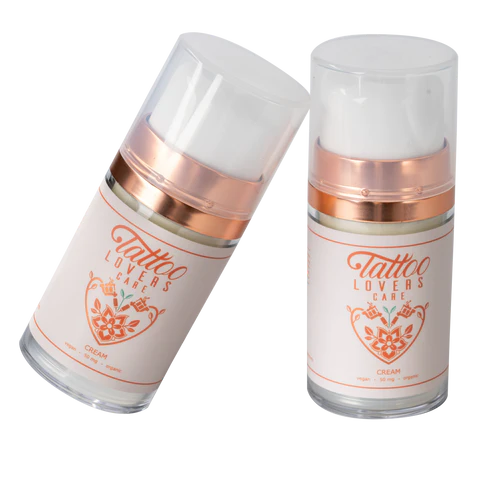
TLC's Tattoo Cream is specially formulated to ease the itch of new tattoos while at the same time hydrating the tattoo deeply.
The natural oils in the cream smell amazing but don't irritate your tattoo. This is because it's made with essential oils that smell great and aid healing.
Using this type of cream actually quickens the healing process.
Week 3: Hydration Is Key
At this point, your tattoo will have gone through the most challenging part of the healing.
You'll have seen massive amounts of dead skin fall off in the shower, held firm, and not scratched your tattoo.
Hopefully.
By week three, you shouldn't need to wash your tattoo as often, just once a day with your daily shower. If you don't take a shower every day, at least wash your tattoo once a day.
You will need to continue to keep your tattoo hydrated.
I don't often see it mentioned in tattoo aftercare guides, but drinking lots of water can make a huge difference in how your tattoo heals.
Our skin is directly impacted by how well-hydrated we keep our body.
Water maintains the elasticity of our skin, and people who stay hydrated have fewer wrinkles, are less prone to scarring, and don't show signs of premature aging.
It stands to reason that because your tattoo is part of your skin, your tattoo will also receive the benefits of staying hydrated.
So through week 3, you'll need to keep the cream and salve close by with a big glass of water. Anytime the glass gets empty, fill it up again.
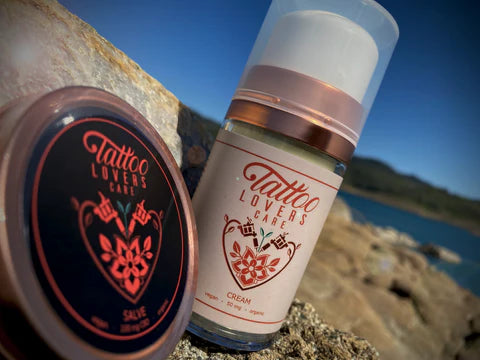
Week 4: Stay Out Of The Sun
By week 4, your tattoo should be mostly healed and out of the danger zone of infection. Sometimes there might still be a little scabbing if your artist used a heavy outline or there was a lot of color.
You'll notice that your tattoo still feels sensitive even though the dead skin and scabs are gone. The reason is that it hasn't completely healed on the inside.
You'll still want to use salves and creams to help with healing and hydration, but once there's no more open skin, you'll need to immediately begin using sunscreen.
The minimum SPF you should use is 30. At this strength, you should be good to go out in the sun. Just remember to reapply the sunscreen several times a day.
We recommend using sunscreen specially formulated for tattoos, like TLC's SPF 30 Sunscreen.
As your tattoo heals, you'll notice that the skin is less sensitive to touch and sunlight, but this doesn't mean you should stop caring for your tattoo.
Develop a skincare routine and use high-quality products, and you'll prolong the life of your tattoo by years.
Why Is Tattoo Aftercare Important
Proper tattoo aftercare is essential for your tattoo's longevity and for avoiding health complications.
Let's be clear, getting a tattoo is very serious. While the tattoo’s content can be silly and sometimes very personal, the procedure itself is a big deal.
Your body is sustaining a lot of trauma in a concentrated area. Your skin and body are very vulnerable to infection during this time.
It's not to be taken lightly and should be approached responsibly.
Looking at aftercare this way is just so you don't get an infection. You also need to maintain the quality of your new tattoo.
Not using good aftercare techniques can severely impact how your tattoo looks. It can:
- Fade your tattoo
- Smudge the outline
- Cause scarring, which distorts the image
- Overall ink loss
You've spent a lot of money on your tattoo and went through a lot of pain to get it. Don't screw it up by not taking care of your new tattoo.
Use premium aftercare products made for tattoos, and you'll notice a difference.
Why Is Long-term Tattoo Aftercare Important
An often overlooked aspect of tattoo aftercare is how to keep it looking great over the long term.
Most people stop caring for their tattoos after the initial healing is done.
Like many things in life, we get used to something and forget about it.
But anyone who uses a skincare routine will tell you that to see results, it happens over the course of a long period of time.
The idea is to dramatically slow down the aging process. In many situations, you can even reverse the signs of aging.
You can do the same thing with your tattoos.
But the only way this works is to begin.
It's best to start your long-term tattoo aftercare routine as your tattoo finishes healing.
You'll want to use the following:
- Salve
- Cream
- Sunscreen
- Serum
Each of these products works together to keep your tattoos looking as fresh and bright as the day you sat in the chair.
You can try to buy each of these from other brands, but their products aren't made for tattoos.
We save you time and money with TLC bundles that are made for aftercare and long-term tattoo skin care.

But what is happening to your tattoo that requires long-term tattoo skin care?
Reasons Our Tattoos Change Over Time
As bad as we don't want it to happen, your tattoo will change over time. You can slow down this change dramatically with a skincare routine, but let's look at the factors that cause our tattoos to change.
Sun
The sun is nearly unavoidable, but you can take steps to avoid the damaging effects of UV rays.
If you want to see the long-term effects of sun exposure on a tattoo, the next time you walk by a construction site, look at the tattoos on the workers.
A lot of these guys have tattoos, but they forget to wear sunscreen day in and day out. Their tattoos become blurred and not well-defined.
Even up close, it's challenging to read their tattoos and tell what they once were. I had a friend whose spiderweb tattoo on his elbow completely disappeared after a few years of working construction.
Age
It's inevitable.
We are all going to grow old one day.
As we age, our skin begins to stretch and sag; unfortunately, our tattoos will stretch and sag too.
Your tattoos will also fade and blur with time, but you can put them off by years if you take care of yourself.
Lifestyle
How we live our lives directly affects how our tattoos look as we age.
If you drink a lot, party, and eat garbage food, your body and skin will reflect that lifestyle.
You'll get away with it while your young, but eventually, hard living will catch up to you.
It's better for you and your tattoos if you take care of yourself from the beginning.
Placement
Where you get your tattoos placed on your body can affect how long the tattoo stays bright.
Remember my friend, the construction worker with a spiderweb on his elbow?
He not only let the sun fade his tattoo, but he also got it on a place of his body that tends to fade more quickly. Other areas that fade fast are:
- Hands/palms
- Face
- Knees/elbows
- Feet
- Crease lines
- Places your clothes rub constantly
Tattoos often fade in these areas because of sun exposure and the skin getting rubbed.
Hands are the perfect example.
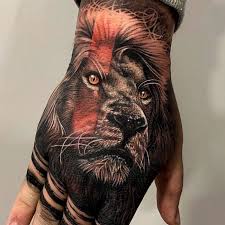
You use your hands A LOT, which means your body is constantly replacing the skin gets rubbed off in your daily life. It’s not huge amounts of skin, but micro amounts everyday that add up over time.
If you work a manual labor job, you'll definitely need to get your hand tattoos touched up more often.
Your hands are also constantly exposed to the elements.
We don't walk around with gloves on all the time, and even if we put sunscreen on our hands, it quickly gets rubbed off going about our lives.
If you still want a tattoo in these areas, try getting simple tattoos without a lot of detail or fine lines that fade with time.
Bad Aftercare
If you start the life of your tattoo with bad aftercare, it means that your tattoo will age much more quickly.
We've covered all the reasons it's vital to take aftercare seriously, and it's worth repeating that inadequate aftercare will hurt your tattoo when looking at it long-term.
How To Keep Your Tattoos Looking New
Knowing how our tattoos change over time means we know how to prevent those changes from happening. Let’s discuss the daily actions we can take to keep your tattoos fresh.
Sunscreen
Using sunscreen is the most obvious answer. You'll want to ensure that you always have sunscreen on you. Don't leave home without it; keep some in the car if you must.
You can also wear clothes to cover your tattoos or avoid going out in the sun altogether.
Wear sunscreen or cover it up.
Moisturizer
Nourishing your skin with creams and salves will make your skin stand out from others.
You can eat well, drink water, and stay out of the sun, but a daily skincare routine is what will make your skin and tattoos glow.
Be sure you use high-quality ingredients made from natural sources, and it's even better when you use products specially designed for tattoos.
If you're looking to make the commitment, sign up for Forevercare, and you'll have everything you need to take care of your tattoos for years to come.
Lifestyle
There isn't a better way to maintain great-looking tattoos than living a clean lifestyle.
Healthy living is how to maintain your tattoos from within, while tattoo aftercare products support the outer parts of your tattoos.
It's essential that you have both working together to get the most out of your tattoos.
You can do several things to prolong your tattoo's life.
- Drink lots of water
- Limit your sun exposure
- Eat healthy foods
- Get lots of sleep
- Avoid excess weight gain/loss
- Establish a skincare routine
Follow these steps, and it'll help to keep your skin from aging prematurely. Besides, focusing on your overall health will have many amazing benefits besides keeping your tattoos fresh. You won't regret it.
Touch Ups
If you get a tattoo in a place that tends to fade, you can get touch-ups. Some artists offer touch-ups for free (you still need to tip them if they do), and others will charge you their hourly rate.
Either way, going over the important parts will bring your tattoo back to life without having to get a completely new tattoo.
How To Make Your Tattoos Heal Faster
The number one way to make your tattoo heal faster is to stick to a ridged aftercare routine.
It's not a hack and doesn't sound entertaining when you hear it, but keeping your tattoo clean without any forms of irritation will result in the fastest healing time.
This means:
- Keep your tattoo clean
- Keep your tattoo hydrated
- Don't pick or scratch your tattoo
- Don't allow sunlight on your tattoo
- Don't submerge your tattoo in water
- Use aftercare products that promote healing
An often overlooked aspect of healing your tattoo more quickly is getting enough sleep. Make sure you are getting at least 8 hours of sleep per night.
What does this have to do with tattoos?
Sleep is when our body heals itself. There might be some healing as you go about your day, but the bulk of the work is done when you hit the sack.

You'll notice that people who work out a lot make sure to get a lot of sleep, and it's because their body needs time to recover. It's healing itself.
Same thing when you get sick. Doctors will tell you to get lots of rest because it's how you get better.
The last thing that can guarantee a faster healing tattoo is products that promote healing.
Some might think of using ointments like Neosporin to prevent infection and increase healing times.
The problem is that you don't want to use those products on a new tattoo.
Here's why.
Neosporin works by creating a barrier to the environment outside of the tattoo, essentially smothering it.
While this might work on minor cuts and scraps, a new tattoo needs oxygen to breathe and heal properly. New tattoos are much more prone to infection, ink loss, and scarring if cut off from oxygen.
The solution is to use products specifically designed for tattoos.
All TLC products are made from natural essential oils meaning they won't smother your tattoo, but they will ease pain, reduce inflammation, and give it oxygen it needs to heal.
Once applied, the salve and cream will sink deep into your tattoo, promoting healing from within; helping complete the natural healing process much quicker.
How To Shower With A New Tattoo
Many tattoo artists forget to talk with their clients about showering, and it's kind of a big deal.
We've already covered it, but it's essential that you don't take baths or submerge your tattoo at all during the healing process.
Doing so increases your chances of an infection, leading to many problems like extreme pain, ink loss, and scarring.
When taking a shower, don't do the following:
- Use a loofah or washcloth
- Use soap with artificial fragrance
- Use soap that isn't antibacterial
- Stay in the shower for a long time
- Shave over the tattoo
Using a loofah or washcloth is way too abrasive for a new tattoo, and once your tattoo starts to flake and scab, it will rub off all the healing layers.
Plus, it'll hurt really bad.

As we've covered before, only use antibacterial and unscented soaps. We suggest using TLC's Foam Soap.
Do not stay in the shower for a long time. Doing so will give you the same results as taking a bath.
You don't want your healing tattoo to get soggy and soft. If a scab gets soft and soggy, it'll fall off, exposing raw skin underneath, which means your tattoo has to heal all over again, lengthening the healing time.
It feels like common sense, but don't shave over your new tattoo till it's healed.
You could cut yourself, and razors are dirty. You don't want the germs and bacteria getting into your new tattoo.
Ask your tattoo artist if you're unsure when to take the first shower. We suggest leaving the plastic wrap on overnight, which would mean taking your first shower the next day, preferably in the morning.
Let's go step-by-step through taking your first shower with a new tattoo.
A step-by-step guide to taking a shower with a new tattoo
- Turn on the shower, but not too hot. If it's too hot, it's going to hurt super bad.
- Remove the plastic wrap if it's still on. Hopefully, the plasma and blood will have stopped leaking by this time. If not, that's ok; it'll rinse off in the shower.
- Take your regular shower but don't put soap on your tattoo or use a loofah or washcloth on it. If soap flows over the tattoo because it's running down your body, that's ok. The idea here is to not wash your tattoo.
- Wait till the end of the shower to wash your tattoo. The reason is that the water flowing over your tattoo rinses away any sort of debris or dried blood. You'll want to wait till the end, though, because you want your tattoo to be as clean as possible when you step out of the shower. It doesn't make sense to clean your tattoo right when you get in the shower only to have dirty soap suds from your body flowing over your tattoo right afterward.
- Getting out of the shower, I would either let it air dry or gently pat it with a paper towel. Don't use a cloth towel. They hold a lot of germs and can infect your tattoo.
- Once dry, apply salve, and if it's healed enough, apply cream as well.
How To Treat An Infected Tattoo
If your tattoo shows signs of infection, you'll need to look at what you're possibly doing that could be causing the infection.
Are you sweating in your tattoo, wearing too tight of clothing, or going swimming? Are you washing your tattoo and doing a good job of keeping it clean, etc.?
If you're doing anything to cause irritation, stop immediately, and clean your tattoo. Do this if it's only showing the first signs of infection, meaning it's red, inflamed, and hurts.
If your tattoo shows puss or further infection, you must immediately call and talk to your tattoo artist.
If you can't get ahold of your tattoo artist, go see a doctor, as you might need to get antibiotics if it's bad.
The number one thing to not do is ignore it. As soon as you see signs of infection, you'll need to take steps immediately to fix the problem.

Signs of infection include:
- Tattoo is bordered by red, inflamed tissue
- Pus or leaking has occurred
- Fever
- Hot and cold flashes
- Red streaking from tattoo
- Swelling
- Pain
Don't put off treating an infection; it could be very dangerous.
Conclusion
With this step-by-step tattoo aftercare guide, you'll be able to successfully keep your tattoo clean and infection free from start to healed.
If the longevity of your tattoo is important to you, you should consider beginning a daily skincare routine today.
Don't wait because every day your tattoo ages is another day you can't get back.
Sign up for Forevercare, and you'll never run out of the tools you need to keep your tattoos looking sharp and clean like the first day you sat in the chair.

SHOP NOW
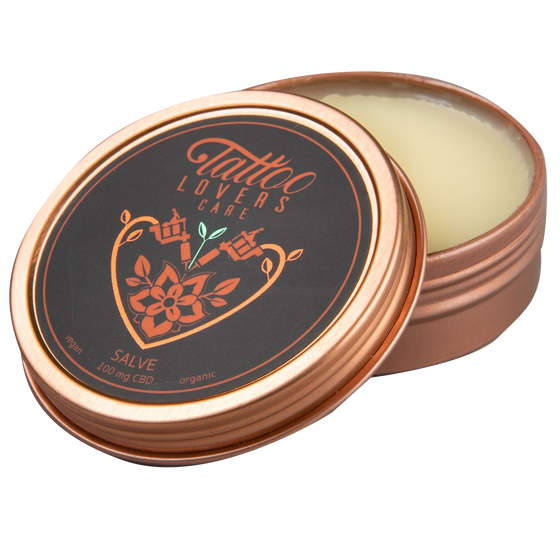
Tattoo Salve
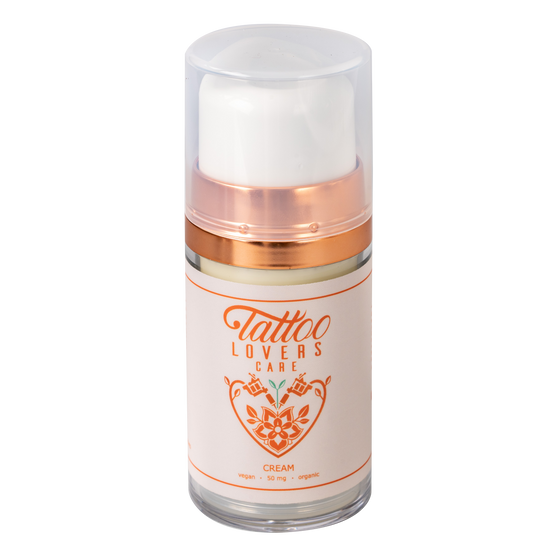
Tattoo Cream
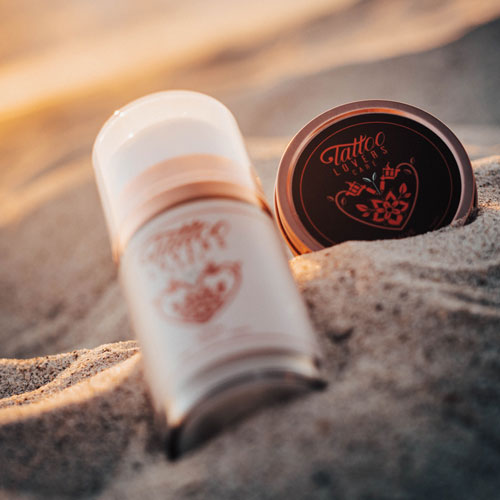
Tattoo Couple Bundle: Salve & Cream
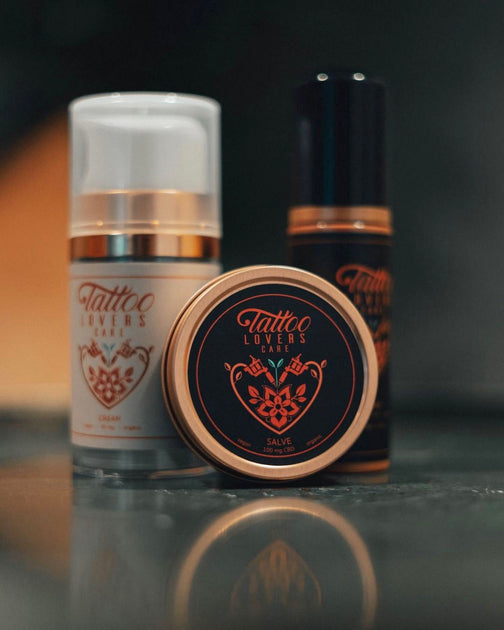
Lovers Trio Bundle: Salve, Cream, & Soap
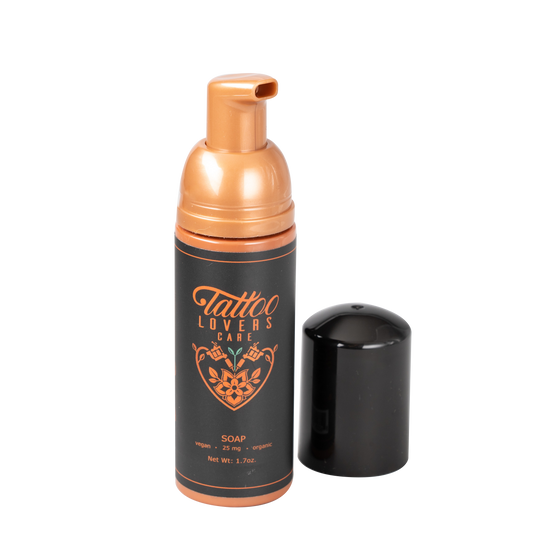
Tattoo Foam Soap
Our mission is to inspire and educate the tattoo community. We have combined our many years of experience in the industry and our love for tattoos to create useful and enlightening content. Join us in this exciting journey in the beautiful art of tattooing.
Welcome to Sorry Mom.
